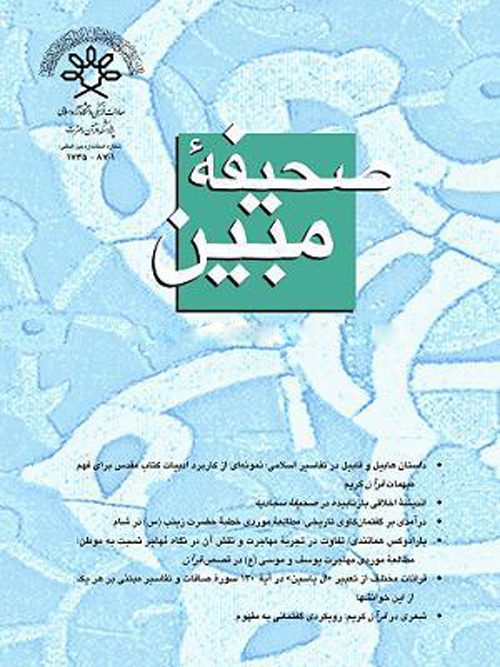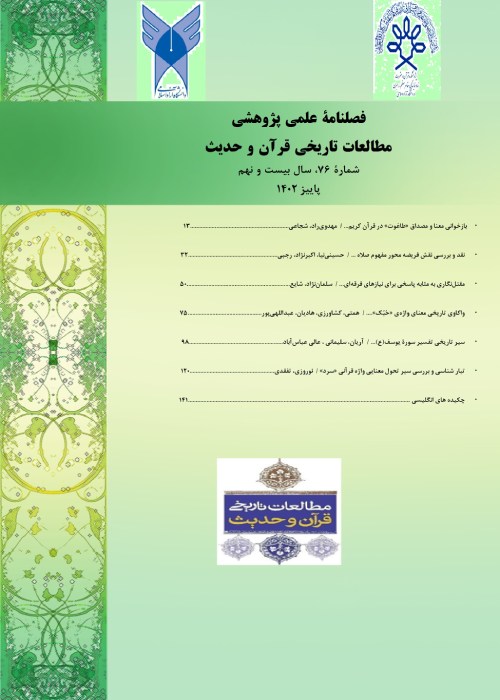فهرست مطالب

نشریه مطالعات تاریخی قرآن و حدیث
سال بیست و سوم شماره 1 (پیاپی 61، بهار و تابستان 1396)
- تاریخ انتشار: 1396/06/01
- تعداد عناوین: 6
-
-
صفحات 7-30
یکی از موضوعات بسیار مهم که درتاریخ و علوم قرآنی بسیار بحث برانگیز بوده و متحمل تفاسیر گوناگون شده است، کلمه «امی» است. این پژوهش با تکیه بر مفهوم شناسی کلمه امی، می کوشد مفاهیم و تفاسیر مختلف واژه امی را ارایه نموده و دیدگاه های مختلف و آراء و نظریات پیرامون آن را مورد نقد و بررسی قرار دهد. با توجه به ارتباطی که بین اهل کتاب و کاربرد این کلمه (امی) در قرآن کریم وجود دارد، به تفصیل علت و تاریخ حضور یهودیت در جزیره العرب مورد کنکاش و تحقیق قرار گرفته است و سپس مدلول و مفهوم آیات قرآن کریم که در آن لفظ امی آمده است، واکاوی شده اند.
کلیدواژگان: قرآن، پیامبر اکرم (ص)، امی، اهل الکتاب، رویکرد تاریخی، یهود، جزیره العرب -
صفحات 37-58
توران پشت نام ناحیه ای است کهن که امروزه بر اساس تقسیمات کشوری از توابع شهرستان تفت استان یزد به شمار می رود. از جمله آثار تاریخی توران پشت باید سنگ نوشته هایی را نام برد که در کنار جاده مال رو، در نزدیکی روستای دره گازه قرار گرفته اند. با بازخوانی متن این سنگ نوشته ها آشکار گردید که قدمت کهن ترین آن ها به نیمه ی اول سده 3ق باز می گردد. بررسی خطوط این کتیبه ها نشان می دهد که در نمونه های قدیم تر ویژگی های خط کوفی با دقت بیشتری رعایت شده و رفته رفته با گذر زمان، ویژگی های این نوع خط کم رنگ تر دیده می شود. به غیر از آیات قرآنی مضامین دیگری همچون اسماء الهی و شعر فارسی نیز بر این کتیبه ها به چشم می خورد. در بخش هایی از این مقاله، درصدد پاسخ به این پرسش بوده ایم که نگارندگان این سنگ نوشته ها با کدام طرز تلقی این نوشته ها را از خود به یادگار گذاشته اند؟ که با تحلیل مضامین به کار رفته در این سنگ نوشته ها، مشخص شد این مضامین نزد متصوفه از اهمیت زیادی برخوردار بوده اند.
کلیدواژگان: توران پشت، کتیبه های قرآنی، خط کوفی، تصوف، شعر فارسی -
صفحات 59-84
دوگانه غیبت امام قایم در تاریخ روایت نگاری های صدر اسلام همواره به عنوان یک گفتمان رایج در میان مسلمانان از هر طبقه در زندگی فردی و اجتماعی بروز داشته است. انگاره شناسی های گفتمانی صورت گرفته حاکی از آن است که این تفکر در روایت نگاری های صدر اسلام در منابع اهل سنت و شیعه بروز جدی دارد و در میان طبقات مختلف مردم، آن را به یک گفتمان غالب، مبدل ساخته است. دوگانه غیبت امام قایم از جمله موضوعاتی است که در عصر حضور معصومان علیهم السلام مورد توجه مسلمانان، به عنوان یک گفتمان و به طور خاص در نظرگاه شیعیان به ویژه دانشوران و نویسندگان بوده و دست مایه نگارش بسیاری از آثار مکتوب در این زمینه قرارگرفته است. دوگانه غیبت امام قایم از مهم ترین رخدادهای تاریخ شیعی است که می توان تاثیرات آن را در روایت نگاری های مکتوب، مشاهده کرد. این مطالعه ضمن بررسی ابعاد انگاره شناسی دوگانه غیبت امام قایم و پاسخ به این سوال که آیا مردم با این گفتمان آشنا بوده اند یا خیر؟ نشان می دهد که این اندیشه از همان صدر اسلام وجود داشته است اما در هر دوره زمانی، در تعیین مصداق خطا و اشکال به وجود آمده است.
کلیدواژگان: مهدویت، گفتمان غیبت، گفتمان پژوهی، روایت نگاری -
صفحات 85-97
وجود روایات فراوان از امام رضا(ع) در جوامع روایی و تاثیر کلامی و فقهی این روایات در نگارش متون تفسیری، ما را بر آن داشت تا در مورد نقش این روایات از نظر روش تفسیری و صبغه کلامی و فقهی در تفسیر المیزان به بحث و بررسی بپردازیم. آنچه مسلم است ورود اقوال تفسیری حضرت امام رضا(ع) در المیزان و تاثیر پرفروغ آن در جهت گیری علامه در المیزان می باشد. این مقاله با بررسی نوع روایات وارده در المیزان و همچنین کتبی که روایات امام رضا(ع) از آن اقتباس گردیده است به جمع بندی و تاثیربخشی این روایات در پنج بخش پرداخته است. در مجموع می توان اینگونه بیان داشت که علامه طباطبایی در تفسیر المیزان از روش و نوع استدلال امام رضا(ع) در ذیل آیات بهره فراوان برده است.
کلیدواژگان: علی بن موسی الرضا، روایات تفسیری، تفسیر المیزان، روش تفسیری -
صفحات 99-139
قرآن شناسان از گذسته به بحث از نزول تدریجی قرآن پرداخته اند و حکمت های بسیاری برای آن ذکر کرده اند؛ مانند: قوت قلب دادن به پیامبر(ص)؛ تربیت گام به گام امت نوپای اسلامی؛ نزول همگام با رخدادها و شرایط دوره نزول؛ حفظ و فهم بهتر آیات قرآن و... . ذکر این حکمت ها، از جهت کمی و کیفی، از دوره ای به دوره دیگر متفاوت است. اصل وقوع نزول تدریجی، با توجه به دلایل و شواهد بسیار مسلم و مورد اتفاق اندیشه وران مسلمان است اما قریب به اتمام حکمت های مذکور با توجه به دلایلی که بر نادرستی آنها می توان اقامه کرد، شایستگی عنوان فلسفه نزول تدریجی را ندارند. بر پایه دلایل و شواهدی که روشن می سازد تمام سور و آیات قرآن پس از وقوع رخدادها، موضوعات و شرایط مقتضی نزول آنها در دوره رسالت نازل شده اند، نزول تدریجی قرآن عبارت است از: نزول پاره پاره و بخش بخش آن به دنبال همین رخدادها و مقتضیات. فلسفه آن نیز، تدریجی الوقوع بودن این رخدادها و مقتضیات است.
کلیدواژگان: نزول تدریجی، حکمت، نقد، اسباب و مقتضیات نزول
-
Pages 7-30
The Arabic word ummi is commonly translated as "unlettered." In the Qur’an, Muhammad is described as "ummi" and traditionally this has meant for Muslims that Muhammad was illiterate, completely unable to read or write. Thus, the fact that he was able to recite the Qur’an should be regarded as a miracle (i'jaz) and evidence that it really does have a divine origin. This paper, according to the verses of the Qur’an and historical evidence, proves that ummi should not be taken to mean illiterate, but rather scriptureless. This would mean that when Muhammad is described as ummi, it denotes the fact that he is not one of the People of the Book or simply that he is not a member of a group which has already received a revelation from God - at least, not until he received the Qur'an.
Keywords: literacy, Illiteracy, Followers of the Book, Immigration of Jews, Hiding the Fact -
Pages 37-58
Turan Posht is a district which according to the present country division of Iran, is considered one of the townships of Taft in Yazd province. Among the historical monuments of this small town, there are some Qur’anic inscriptions found along a road near a small village called “Darh Gaz”. Careful inspection of these inscriptions, revealed that the age of the oldest of the inscriptions go back to the first half of the third century. The examination of the text showed that in the old versions of the Kufi script, more attention was paid to the observing of its features, which were later forgotten as the time passed. Besides the Qur’anic verses, other material such as divine names and Persian poetry are found in the inscriptions. In this study, we have tried to answer this question that why were these inscriptions made? The analysis of the concepts used in these inscriptions clarified that they have been of great importance among the Muslim Mystics.
Keywords: Turan Posht, Qur’anic Inscription, Kufi script, Taṣawwuf, Persian poetry -
The Dual Discourse of Cheibat (Occultation)-Imam Qaim In the Narrations of the First Islamic CenturyPages 59-84
The dual concept of Gheibat (Occultation) -Imam Qā’im in the history of narrations written in the early Islam has been considered a common discourse among Muslims of various classes in their social and individual life. Discourse hypothesis done in this regard indicates that the existence of this concept in the narrations of early Islam in Sunni and Shiite sources is extensive and has been a common discourse among different classes. The dual concept of Gheibat -Imam Qā’im has also been an issue which drew Muslim attention during the lives of the infallible Imams and was considered a common discourse among Shiite scholars.And was the subject of may written works. The dual concept of Gheibat -Imam Qā’im can be regarded as one of the most significant events in the Shiite history whose signs can be traced in the written narrations. This study tries to investigate the effects of this concept and answer this question that whether or not the people were familiar with this discourse. Based on the findings of this study, the notion of Gheibat -Imam Qā’im was a common subject from the early Islam, although in different times it was applied to refer to different peopleم
Keywords: Mahdaviat (belief in a deliverer) Discourse of Occultation_Discourse study_Narration -
Pages 85-97
The existence of many narrations from Imam Reza in the narrative books and the theological and jurisprudential impact of these narrations in the writing of interpretive texts have led us to discuss the role of these traditions in terms of the interpretative method and the juridical aspects of the interpretation of al-Mizan. What is certain is the introduction of the Imam Reza interpretative narratives in al-Mizan and its impact on the Allameh's orientation in al-Mizan. This article, by examining the type of narratives in al-Mizan as well as the written text of Imam Reza narratives, has summarized these narratives in five sections. In sum, it can be stated that Allameh Tabatabai in the commentary of al-Mizan has benefited from the method and type of reasoning of Imam Reza in the following verses.
Keywords: Ali ibn Musa al-Reza, interpretative narrations, al-Mizan commentary, methodology of interpretation -
Pages 99-139
Qur'anic scholars have discussed the gradual descend of the Qur'an and listed many reasons for it; Such as strengthening the heart of the Prophet (pbuh); step by step training of the new Islamic Ummah; Landing commensurate with the events and conditions of the descending period; better preservation and better understanding of the Quranic verses; ... . These reasons are different from the era of quantitative and qualitative aspects of the era. The principle of the gradual decline of the Qur'an is based on very clear and accepted reasons for Muslim scholars But almost all of these wisdom do not deserve the gradual decline of philosophy, due to their incorrect reasons. There are reasons and evidence to show that all verses and surahs of the Quran have been revealed after the events and conditions in the era of the Quran revelation . According to these reasons, the gradual revelation of the Quran means the decline of its section after these events and conditions. Its philosophy is the gradual occurrence of these events and requirements.
Keywords: gradual descend, wisdom, critique, Asbab al-nuzul


